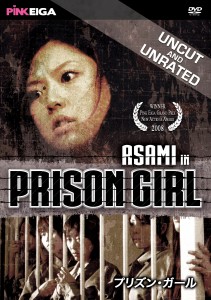Director: Naoyuki Tomomatsu
Writer: Chisato Okawara
Producer: Masaru Ikeda
Cast: Asami, Yoko Satomi, Hiroaki Yanagi, Mari Yamaguchi, Yukiharu Inoue, Fumiaki Kato
Running Time: 60 min.
By Paul Bramhall
Out of all the Japanese sub-genres, the Pink Eiga movie is perhaps the most confusing to try and explain. Literally translated to English as Pink Movie, the genre is different to that of AV, standing for Adult Video, which is most easily described as Japanese porn. Pink Eiga on the other hand is a different kind of beast, having been around since the 1960’s, as one of the directors working in the industry perhaps best explains – Pink Eiga is an “art genre movie with sex scenes.”
This is actually a fairly accurate summary of what can be expected from a Pink Eiga flick, and there’s a certain old school romanticism to the way they’re made even today. Despite the revolution of digital filming, and regardless of the fact that the movies are always on very limited budgets and shooting schedules (3 days is normal), most Pink Eiga movies are still shot on 35mm and edited by hand. For the directors and performers of these movies it’s a serious business, and one that almost all are proud to be a part of. Directors like Yojiro Takita, who won the 2009 Foreign Language Oscar for his movie Departures, and Masayuki Suo, who directed the original Shall We Dance of which the 2004 Hollywood remake is based on, both started out in the Pink Eiga genre.
Skip forward to 2008, and a US based company by the name of Pink Eiga emerged, whose enthusiastic mission was to release some of these unseen movies onto western audiences. And yes, their name is the equivalent of a company calling themselves Romantic Comedy and only releasing Hugh Grant movies. A couple of years later though and the DVD market had all but dropped out, and the company switched to a VOD only format. Thankfully, after several fans requesting for a return to the days of being able to physically have the movies on DVD, the guys at Pink Eiga have duly obliged, and one of their first new releases is Prison Girl.
One of the joys of a Pink Eiga movie is having no idea exactly what you’re about to get yourself into, it’s a broad label, and the movies can cover everything from horror to thriller to science fiction. Ironically the nudity and sex scenes to be found in these movies are not always there for the purposes of titillation, sometimes they’re there because, well, it’s an art genre movie with sex scenes right? Prison Girl stars Asami, a name that anyone even slightly familiar with the Japanese low budget splatter genre will be familiar with. The co-star of Machine Girl, made the same year as Prison Girl, Asami quickly became a fan favorite, and can be seen in some state of undress in almost every splatter movie that’s come out since then, most recently graduating to action star (and woman) in 2014’s Gun Woman.
In Prison Girl she plays Ayaka, a recently married housewife who longs to go back to work, but has bigger issues in that she has a recurring dream of being a prisoner in a woman-only jail, in which she’s sexually assaulted by the sadistic guards. Within the first 5 minutes Asami has been stripped and frisked by the prison guards, wakes up in a state of shock, and has her husband tell her that she should probably go to hospital for some psychotherapy. Things move fast in the world of Pink Eiga, and like most of these movies, Prison Girl clocks in at just 60 minutes, meaning there’s never any fear of things getting bogged down in exposition.
What’s surprising though is exactly how much director Naoyuki Tomomatsu crams into such a short runtime. Tomomatsu is most well known for the 2009 splatter movie Vampire Girl vs. Frankenstein Girl, however he’s a director that’s largely stayed within the Pink Eiga genre, seemingly finding his niche with his Rape Zombie: Lust of the Dead series (currently on its 5th installment!). If the title sounds offensive, well, don’t forget to check out the Groper Train series either. The titles certainly don’t shy away from trying to capture your attention.
It’s not long into Prison Girl that things actually get quite unsettling, sudden images flash onscreen of Asami being drenched in blood while laughing manically, juxtaposed with seemingly serene scenes of her preparing dinner for her husband. She begins to see a therapist to try and get to the bottom of why she’s having the dreams, but instead of helping they only seem to get more vivid – characters from her every day world also begin to appear in her dreams, and most disturbing is the discovery that she’s imprisoned for killing her husband. As she begins to question her sanity, at the same time we as the viewer are also asked to do the same – is she a bored housewife longing for some sexual excitement, or is she a murderer in prison daydreaming of having a normal life again?
Amongst the obligatory nudity and sex scenes, of which there are plenty (and which it’s also worth noting the other difference between Pink Eiga and AV – in Pink Eiga there’s no actual penetration, it’s all simulated), there are many nice touches that make you appreciate the level of craftsmanship put into making it. Shots like the sudden focus on a pool of blood forming on the carpet from a plastic shopping bag, due to a defrosting packet of mincemeat, are enough to make you feel suitably uneasy, and the final shot is one that also lingers in the memory. By the time an hour has passed what you think is going to be a bored housewife having erotic dreams for the next 60 minutes, has ended up being more of a psychological horror which goes into the darker corners of a woman bored by her sudden need to adhere to domestic life.
Asami won the New Actress Award at the Pink Eiga Grand Prix of the same year for Prison Girl, and it was an award well deserved. At times her performance is reminiscent of Meiko Kaji in Female Convict Scorpion: Jailhouse 41, and also just like in that movie, there’s a scene when the other inmates make a chorus of whispering her name as she’s brought out to be punished by the guards. While the movies exist in two completely different worlds, it’s admirable that Tomomatsu shows the influence of the past masters.
It has to be said that the low grade film stock gives the movie a much older look than it actually is, combined with the fact that there’s not a single shot of a cell phone or computer during the whole runtime, Prison Girl could just as well have been made in 1978 as it could 2008. This is all part of the charm and mystique that is the world of Pink Eiga though, a genre which has regularly been close to vanishing, but somehow it always finds a way back, and with plenty more releases in the pipeline, Prison Girl should serve as a notable introduction to the genre.
Paul Bramhall’s Rating: 6.5/10




